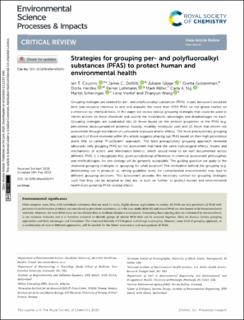| dc.contributor.author | Cousins, Ian T. | |
| dc.contributor.author | DeWitt, Jamie C. | |
| dc.contributor.author | Glüge, Juliane | |
| dc.contributor.author | Goldenman, Gretta | |
| dc.contributor.author | Herzke, Dorte | |
| dc.contributor.author | Lohmann, Rainer | |
| dc.contributor.author | Miller, Mark | |
| dc.contributor.author | Ng, Carla A. | |
| dc.contributor.author | Scheringer, Martin | |
| dc.contributor.author | Vierke, Lena | |
| dc.contributor.author | Wang, Zhanyun | |
| dc.date.accessioned | 2020-06-17T07:15:25Z | |
| dc.date.available | 2020-06-17T07:15:25Z | |
| dc.date.created | 2020-06-12T11:05:07Z | |
| dc.date.issued | 2020 | |
| dc.identifier.citation | Environmental Science: Processes & Impacts. 2020. | en_US |
| dc.identifier.issn | 2050-7887 | |
| dc.identifier.uri | https://hdl.handle.net/11250/2658325 | |
| dc.description.abstract | Grouping strategies are needed for per- and polyfluoroalkyl substances (PFAS), in part, because it would be time and resource intensive to test and evaluate the more than 4700 PFAS on the global market on a chemical-by-chemical basis. In this paper we review various grouping strategies that could be used to inform actions on these chemicals and outline the motivations, advantages and disadvantages for each. Grouping strategies are subdivided into (1) those based on the intrinsic properties of the PFAS (e.g. persistence, bioaccumulation potential, toxicity, mobility, molecular size) and (2) those that inform risk assessment through estimation of cumulative exposure and/or effects. The most precautionary grouping approach of those reviewed within this article suggests phasing out PFAS based on their high persistence alone (the so-called “P-sufficient” approach). The least precautionary grouping approach reviewed advocates only grouping PFAS for risk assessment that have the same toxicological effects, modes and mechanisms of action, and elimination kinetics, which would need to be well documented across different PFAS. It is recognised that, given jurisdictional differences in chemical assessment philosophies and methodologies, no one strategy will be generally acceptable. The guiding question we apply to the reviewed grouping strategies is: grouping for what purpose? The motivation behind the grouping (e.g. determining use in products vs. setting guideline levels for contaminated environments) may lead to different grouping decisions. This assessment provides the necessary context for grouping strategies such that they can be adopted as they are, or built on further, to protect human and environmental health from potential PFAS-related effects. | en_US |
| dc.language.iso | eng | en_US |
| dc.rights | Navngivelse-Ikkekommersiell 4.0 Internasjonal | * |
| dc.rights.uri | http://creativecommons.org/licenses/by-nc/4.0/deed.no | * |
| dc.title | Strategies for grouping per- and polyfluoroalkyl substances (PFAS) to protect human and environmental health | en_US |
| dc.type | Peer reviewed | en_US |
| dc.type | Journal article | en_US |
| dc.description.version | publishedVersion | en_US |
| dc.rights.holder | This journal is © The Royal Society of Chemistry 2020 | en_US |
| dc.source.journal | Environmental Science: Processes & Impacts | en_US |
| dc.identifier.doi | 10.1039/D0EM00147C | |
| dc.identifier.cristin | 1815212 | |
| dc.relation.project | NILU - Norsk institutt for luftforskning: 117031 | en_US |
| cristin.ispublished | false | |
| cristin.fulltext | original | |
| cristin.qualitycode | 1 | |

